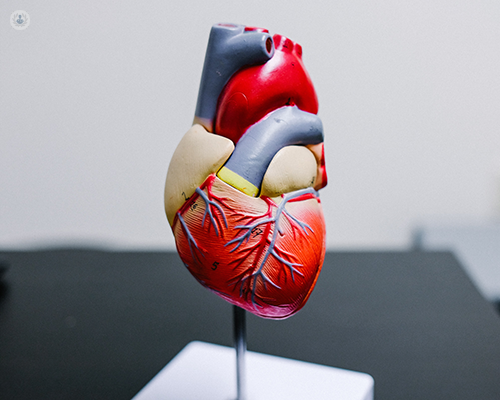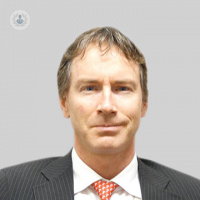When the first ablation fails: Arrhythmia after atrial ablation
Escrito por:If you experience arrhythmia, a doctor may recommend atrial ablation to burn and destroy the abnormal area of heart tissue that is causing the arrhythmia. While ablation will generally restore your normal heart rhythm, it is important to remember that arrhythmia may still occur after the procedure, in some cases.
Here to provide a detailed insight into arrhythmia after atrial ablation, including causes, prevention and treatment, is esteemed cardiologist, Dr Mark Gallagher.

What is arrythmia?
Arrhythmia is a very broad term that covers any disturbance of the heart’s rhythm. Used in its correct sense, arrhythmia includes:
- Circumstances where the heart runs too fast
- Circumstances where the heart runs too slowly
- Circumstances where the heart is at the right rate, but it is running in an improper pattern. Instead of going bump, bump, bump, it is going in an irregular manner which feels uncomfortable and is associated with a much less efficient performance of the heart and, in some cases, a weakened heart in the long term.
Why can arrhythmia occur after atrial ablation?
When we perform a procedure on the heart, what we are trying to do is isolate problems by creating fire breaks. These fire breaks, however, can lead to other problems - for example, a new circuit where abnormal electrical activity runs around the fire break. This could occur if there is a gap in the fire break or if there is a gap between the fire break and another obstruction, such as the heart valves which control the direction of blood flow.
As well as this, given that we are dealing with abnormal hearts to start with (that is, hearts that have bits of scarring, often in unpredictable locations) the heart can also create the possibility of scarring.
In some cases, eliminating the atrial fibrillation can also sometimes reveal problems that were previously concealed. Take for example, an atrium that has multiple patches of scarring in the septum and in the roof. As long as this scarring is in atrial fibrillation, the irregular tachycardias that can run through these circuits are concealed. Once the arrhythmia is managed, the circuits have no option but to become apparent.
Should patients be worried about an irregular heartbeat after atrial ablation?
Patients should not worry about atrial arrhythmias too much, because most of these can be fixed.
Still, atrial arrhythmias should not be ignored. Patients should take note and bring them to the attention of an electrophysiologist to be carefully examined and corrected, if appropriate. Once we have a good quality electrical recording of the heart’s rhythm, we can assess it and decide if it requires additional ablation.
How long do arrhythmias usually last after ablation?
This can be interpreted in two ways. First of all, what is the time course of the occurrence and the resolution of arrhythmia? Secondly, how long do the individual episodes last?
Recently, we have seen a phenomenon where the muscle that has been burned (and is then healing) becomes irritable, produces extra beats, and produces little runs of extra beats. These bits of activity occur in the first few months after an ablation – particularly, in the first three – and usually die out over time as the muscle heals. For this reason, arrhythmias that occur in the first three months after ablation are treated with a very conservative approach. From six months afterwards, any arrhythmia that is recorded is likely to be a long-term situation.
The arrhythmias that are most concerning now are the ones that last for long periods (which represent electrical activity running in circles). This is because these require resolution by interruption of the circuits with the creation of new ablation lesions.
How can arrhythmia be prevented following atrial ablation?
From a doctor's side, we try to prevent arrhythmias by forming effective lesions that join up to form part of a pattern. The goal is to never put a lesion on its own; every burn has to connect to a burn which then connects to another burn, to either form a circle of burns isolating a vein or another area of abnormality or to join a healthy edge of muscle such as one of the heart valves or one of the superior vena cava (the largest veins in the body).
With patients, the factors that cause atrial fibrillation in the first place have to be addressed very effectively. Age is the major risk factor for the onset of arrhythmia, but because this cannot be changed, we have to pay double the attention to the other factors involved.
One of these is alcohol consumption, which must remain low. A sensible way to achieve this is to follow the old-style upper limit of 14 to 21 units per week.
The other factor is obesity. For this reason, patients who have undergone atrial ablation should carefully try to maintain a very healthy body mass index through dietary means and regular exercise. Patients can either count their steps, trying to stay well above 10,000 a day, or try exercise for a continuous one-hour period at least once every day.
How can arrhythmia be treated?
Arrhythmia can be treated in three ways: leaving it alone, prescribing medication to manage it, or fixing it during a surgical procedure. Although the term arrhythmia is too broad to be able to apply all these terms in each situation, a decision is generally made based on the severity of symptoms and based on the patient’s individual characteristics. This helps to determine whether medication is needed to damp the arrhythmia down or whether a procedure is needed instead to eliminate the arrhythmia permanently.
If you are experiencing arrhythmia after atrial ablation and you wish to seek expert assessment for it, do not hesitate to visit Dr Gallagher’s Top Doctors profile today.


